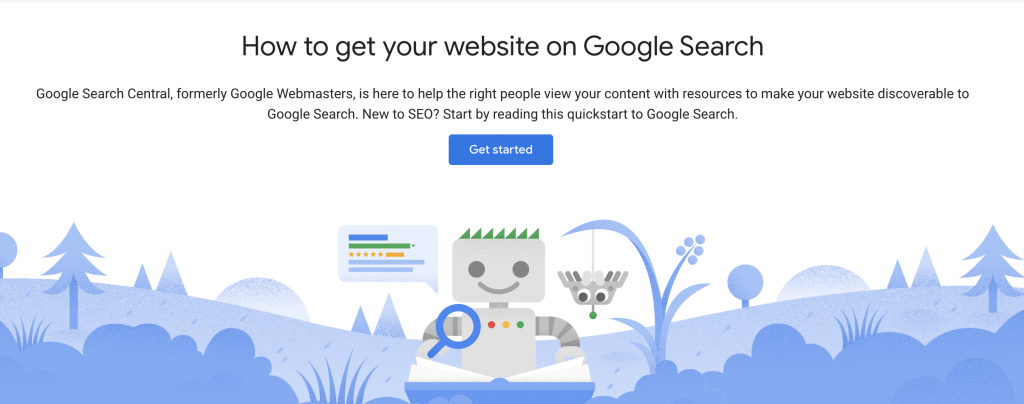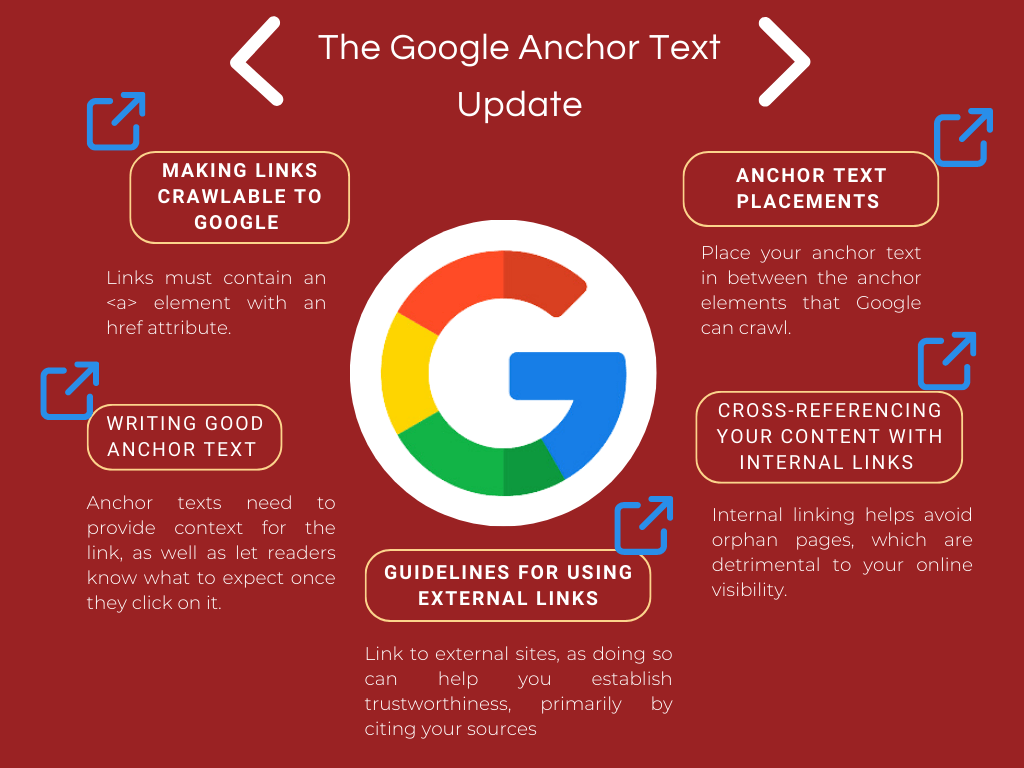Google recently expanded its SEO Link Best Practices document in February 2023 to include new guidelines for how to use anchor text correctly.
Originally, the document focused on tips for creating crawlable links, but it has since been updated to include the following:
- Recommendations for placing anchor text
- Anchor text guidelines
- How to format internal & external links
It’s crucial for SEOs to understand and adapt to these new best practices to retain SERP rankings.
Backlinks and internal links are a crucial part of any SEO strategy, so you need to make sure you’re formatting your anchor text properly.
Generic anchor text with bad placement could negatively affect your SEO profile, as could poorly formatted internal & external links.
Writing good anchor text is more important than ever in 2023, which is why you need to pay close attention to the new guidelines found in the Anchor Text Google Update.
The good news?
We’ve already scoured over the new document, and we’ve prepared this guide which contains everything you need to know about the update.
Not only that, but you’ll learn more about the different types of anchor text and how best to use them along the way.
Read on to discover how you can tweak your link anchor text for better search engine optimization.
What’s the Anchor Text Google Update?
The folks at Google have been rolling out updates like crazy ever since December 2022, when they announced the Link Spam Update and updates to their Quality Rater Guidelines (adding the extra E to E-A-T).
With all the commotion those two updates caused, don’t feel bad if you weren’t aware of the expansion to Google’s SEO Link Best Practices.
The document is part of the SEO fundamentals found in Google Search Central, and it’s intended to be a guide for SEOs eager to get their content ranking on the platform.

In particular, this document covers how webmasters should format anchor text for hyperlinks to make them more visible to Google’s crawlers. It also provides guidelines for using internal & external links in your content.
These new edits are significant because they provide valuable insight into how anchor text affects search engine optimization for Google. For instance, the document provides some examples of high-quality anchor text that’s descriptive, concise and avoids keyword stuffing.
You can’t engage in link-building techniques without writing anchor text, which is why SEOs need to pay close attention to the guidelines found in this document.
Without further ado, let’s dive into the specifics of the Anchor Text Google Update.

Making links crawlable to Google
The first section was the entirety of the original document, which you can still find courtesy of the Wayback Machine.
It covers how web developers need to format their links so that Google can crawl & index them.
Essentially, Google’s crawlers will only discover your link if it’s an <a> HTML element, also known as an anchor element, with an href attribute.
If you don’t include an href attribute with the anchor element, Google’s crawlers won’t be able to identify the URL due to script events. Therefore, if you want your links to count toward your SEO profile, they all must contain an <a> element with an href attribute.
The crawlers won’t be able to parse and extract URLs from other formats, so you need to stick to anchor elements & href attributes like glue.
Here are some formats you SHOULDN’T use:
<span href=”https://www.thehoth.com”>
<a onclick=”goto(‘https://www.thehoth.com’)”>
While Google may still attempt to parse these formats, there’s a slim chance it’ll be successful.
Here’s a quick example of proper link formatting:
<a href=”https://www.thehoth.com”>
In this scenario, Google’s crawlers will have no problem identifying the URL in your hyperlink, so ensure all your links adopt this format going forward.
Anchor text placements
Next, the document covers where to place anchor text in the code for hyperlinks. It’s crucial to place your anchor text in the right spot; otherwise, you’ll confuse Google’s crawlers.
You need to place your anchor text in between the anchor elements that Google can crawl. That will ensure that the crawlers identify & comprehend your anchor text, which is what you want.
Sticking with the properly formatted example above, adding anchor text into the mix would look like this:
<a href=”https://www.thehoth.com”>white label digital marketing services</a>
As you can see, the anchor text is enveloped in the <a> element, which means Google will be able to crawl it properly.
For this example, ‘white label digital marketing services’ is the anchor text that would display for the hyperlink to The HOTH website.
In addition, there are also guidelines for formatting alt text for image links. Whenever there’s an image link, Google will use the alt attribute of the img element as its anchor text, hence the need for writing alt text for your images.
Here’s an example of how to format alt text for an image:
<a href=”https://www.thehoth.com”><img src=”content-creation.jpg” alt=”order HOTHBlogger”/></a>
Here, the anchor text for the image link would encourage readers to order our blog creation services, as it’s listed next to the alt attribute.
Writing good anchor text
Google also provided some detailed guidelines for writing anchor text, which is extremely useful information for SEOs & content writers.
That’s because there’s a specific writing style for anchor text that Google crawlers prefer, and adhering to it will help your SEO profile.
Specifically, good anchor text is concise, descriptive, and relevant both to the page it’s on and that it links to.
Your anchor text needs to provide context for the link, as well as let readers know what to expect once they click on it.
High-quality anchor text not only makes it easier for Google to crawl your links but also helps users navigate your site more easily.
Pro tip: Google considers phrases like ‘click here’ and ‘read more’ to be far too generic. That’s because the text isn’t descriptive, provides no context, and doesn’t set the stage for readers. Even though these two phrases are extremely common for hyperlinks, you’re best to stop using them in favor of more descriptive, relevant anchor text.
Here’s an example of high-quality anchor text that’s helpful to search engines and readers:
To check your current Google rankings, you can use our <a href=”https://www.thehoth.com/search-engine-rankings/”>free Google Rank Checker tool</a>
The anchor text is descriptive & relevant and sets the stage for what readers can expect from the linked page (a free tool to check their current website rankings on Google).
Avoid placing too many links next to each other
Another no-no for anchor text is to place too many links next to each other, as that can confuse Google’s crawlers (and readers, for that matter).
For instance, you shouldn’t cram a bunch of links into one piece of anchor text, which is known as chaining links.
Remember, the surrounding text to your links provide context to Google’s crawlers.
Therefore, if you don’t have at least a few words providing context for each link, Google’s crawlers won’t be able to parse them properly. Not only that but chaining links makes it difficult for readers to distinguish each link, which means they’ll probably miss a few or become confused.
Instead of chaining links together, space them out and provide a few words of context for each one, and your SEO profile will benefit as a result.
Cross-referencing your content with internal links
The next section of the document covers how SEOs should approach internal links. While backlinks tend to steal the focus for most link-building strategies, a logical internal linking structure is a necessity for any website eager to gain online visibility.
The document points out that internal links help Google make better sense of your website, which is good news for your SEO.
Besides that, internal links are also useful for readers, and they keep them engaged in your content loop. By linking to related articles, blogs, and product pages in your content, you’ll improve key metrics like:
- Bounce rate
- Dwell time
- More organic traffic
- More leads and conversions
Whenever you create a new piece of content for your website, take some time to think about other pages & resources on your site that can help users better understand your article.
Internal linking helps avoid orphan pages, which are detrimental to your online visibility.
What’s an orphan page?
It’s a page on your website that has no internal links pointing to it. As such, it’s extremely difficult (and sometimes impossible) for readers and website crawlers to discover an orphan page.
It took time, effort, and resources to create every page on your website, which is why they all need internal links pointing at them from at least one of your web pages. That way, they’ll at least be crawled and indexed so they can appear on search engines like Google, and you won’t waste your time and money.
Guidelines for using external links
Lastly, the Anchor Text Google Update addresses the use of external links for SEO campaigns.
They make a point to mention that you shouldn’t be afraid of linking to external sites, as doing so can help you establish trustworthiness, primarily by citing your sources.
Whenever you mention a statistic or fact that you found online, don’t hesitate to link to the original page (so long as it’s a trustworthy source).
The document also provides ways to link to external pages that you DON’T want to be associated with your SEO profile.
How do you do that?
You can by using a nofollow tag to negate the link juice from a hyperlink.
That will enable you to link out to an undesirable website while not lending it any of your domain authority and vice-versa.
You may be wondering why you would want to include an undesirable external link in your content, but there are actually plenty of reasons.
As an example, let’s say you discover a website badmouthing a product that you endorse, and you want to write a rebuttal piece. In doing so, you’d need to provide a link to the original piece of content, but you definitely don’t want to give them any link juice, and you don’t want their DA (domain authority) to affect yours, either.
This is the perfect scenario for using a nofollow tag.
Sponsored tags for paid backlinks
Also, ever since Google started using SpamBrain to detect purchased backlinks in late 2022, using a sponsored tag is a must for any links that you buy.
If your website has a forum or Q&A session where users can post links, you’ll definitely want to nofollow those links as well (otherwise, a low-quality link posted by a forum user can negatively affect your domain authority).
That’s a complete summary of all the expanded information found in the Anchor Text Google Update. As you can see, Google’s team added quite a bit to the document, and the information is especially important to digital marketers, web developers, and SEOs.
Key Takeaways from the Anchor Text Google Update (What it Means for Your SEO)
Now that you’re more familiar with everything found in the update, what does it mean for you?
How will you have to adapt your SEO & content marketing strategy to ensure your anchor text & external links are formatted the way Google wants?
You’ll need to closely follow Google’s guidelines for formatting anchor text if you want Google to be able to parse your links properly.
In particular, that means using natural language, providing context for links, and being descriptive while avoiding keyword stuffing.
Here are the top ways you’ll need to adjust your SEO strategy to adhere to these new guidelines.

Google will use the title attribute if the anchor text is missing
A valuable insight found in the Anchor Text Google Update is that their crawlers will default to using the title attribute as clickable text if the anchor text is missing.
So if you forgot to add anchor text, but you have a title attribute for your link, Google will use that as the anchor text instead.
This is useful knowledge for SEOs and web developers, as you won’t have to format anchor text for all links containing title attributes. That can save you quite a bit of time if you’re formatting multiple links at once, as you can simply skip the ones that have title attributes (as long as the title attribute serves as good anchor text).
That’s because the official use of the title attribute is to help describe the purpose of a link, which is also what anchor text does.
The W3C, the standards-making entity for HTML, even states that the official purpose of a title attribute, when applied to an anchor element (<a>), is to describe the purpose of a link, along with the anchor text.
Also, title attributes are not unique to anchor elements. It’s a global attribute, which means it can apply to all elements, including paragraphs, italics, and even headings like H1 & H2.
Avoid using extended anchor text
You’ll see the best results whenever your anchor text is concise and to the point. Anchor text that’s too long will likely confuse Google due to scripting issues.
As such, you’ll need to keep it short when writing anchor text for your hyperlinks.
It’s a balancing act determining the right length for your anchor text while also making it relevant & descriptive.
As a rule of thumb, keep your anchor text between 6 – 8 words, and even less than that if you can manage it.
The W3C states that the purpose of anchor text is to describe the purpose & context of a link contained within an anchor element. It’s meant to be a short, concise description, so going on for too long isn’t recommended.
As long as you keep it short and properly format your HTML when writing anchor text, Google shouldn’t have any trouble crawling & parsing your links. The W3C standards reinforce the need for understanding the correct use of HTML.
Get it wrong, and you could wind up costing yourself SERP rankings and organic traffic, which is why it’s worth taking seriously.
Natural language is more important than keywords
Google’s algorithm doesn’t hand out brownie points whenever it detects a keyword in your anchor text.
Instead, Google uses BERT to understand and comprehend natural language.
In the past, it used to be beneficial to cram as many keywords into your anchor text as you possibly could, and some SEOs still haven’t broken the habit.
Yet, Google’s algorithm has been updated many times since then, so you’re better off writing natural anchor text that describes the purpose of your link.
Providing context for your links is also an integral part of working with the BERT algorithm. As stated before, Google’s crawlers look to the words that occur before & after a hyperlink to infer its context.
So instead of spamming target keywords in and around your link, provide at least a few words providing the proper context for search engines and readers.
Putting it all together
To summarize, the way SEOs should approach hyperlinks & anchor text has changed due to the Anchor Text Google Update.
No longer do spammy techniques work, like cramming every target keyword into a tiny piece of anchor text.
Instead, your anchor text must:
- Be contained within an anchor element (<a>)
- Be concise, relevant, and descriptive
- Provide proper context for the linked page
- Use natural language to describe the purpose of the link
Follow these guidelines, and you’ll find the most success with your internal & external links, which will enhance your SEO profile.
If you write sloppy anchor text or chain links together, you’ll only confuse Google’s crawlers, which means they probably won’t properly parse your URLs.
The 8 Different Types of Anchor Text
Lastly, let’s take a quick look at the 8 different types of anchor text that you can use in your content.
That way, you’ll know which type of anchor text to use in any given situation. Combine that with the updated guidelines found above, and you’ll be unstoppable.

#1: Exact-match anchor text
The first type is exact-match anchor text, which means the text contains a keyword that’s an exact match for the page it links to.
An example would be using the word ‘digital marketing’ as anchor text for a blog post that talks about digital marketing.
This type of anchor text works best for guest blog posts, PBNs, and resource pages.
#2: Partial-match anchor text
If the anchor text is nearly identical to the type of page it links to, it’s a partial match.
For instance, if you used the anchor text ‘digital marketing strategy guide’ to link to a blog post about digital marketing, it’d be a partial match. This type of anchor text works great when you want to include a keyword without being too on the nose about it.
#3: Branded anchor text
This type of anchor text occurs whenever you use a brand name as the clickable text for a hyperlink. An example would be using the word ‘Nike’ as anchor text to link to Nike’s website.
#4: Naked link anchors
Sometimes SEOs choose to use hyperlinks that contain no anchor text, which are known as naked links. An example would be typing www.thehoth.com instead of using anchor text to mask the hyperlink.
#5: Generic anchor text
While this is a type of anchor text, it’s one that Google doesn’t want anyone using anymore. Simple anchor text phrases like ‘click here’ and ‘buy now’ are far too generic in the eyes of Google, and they don’t provide enough context for the page you’re linking to.
In light of the Anchor Text Google Update, avoid this type of anchor text in the future.
#6: Image anchor
Whenever you use an image as a link, Google will use the alt attribute as the anchor text, hence the need for alt text for all images.
#7: Keyword variations
Variating your keywords will make your anchor text more unique and interesting. For instance, if our keyword is ‘digital marketing,’ you can create variations like:
- What is digital marketing
- How to do digital marketing
- Digital marketing strategies
#8: Brand + keyword
Lastly, you can combine branded anchor text with one of your keywords, such as ‘Nike digital marketing.’ If you choose to use this type of anchor text, remember not to spam keywords and use natural language wherever possible.
Final Thoughts: Anchor Text Google Update
How you format your anchor text matters for your SEO, and it certainly matters to Google.
The updated guidelines for anchor text and links contain quite a bit of useful information for SEOs, web developers, and digital marketers.
The best practices found in this document need to become habitual if you want to find success with your link-building strategies in the future.
Need help developing a successful SEO strategy for your business?
Then don’t wait to check out our five-star managed SEO services at HOTH X. Our team consists of SEO gurus & digital marketing experts that are well-versed in all the latest developments in the industry, so don’t wait to book a call today.



